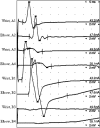Piso-hamate hiatus syndrome in a patient with Riche-Cannieu anastomosis
- PMID: 23519507
- PMCID: PMC3624483
- DOI: 10.1136/bcr-2013-008601
Piso-hamate hiatus syndrome in a patient with Riche-Cannieu anastomosis
Abstract
Various nerve anastomoses and anatomic variants in the nervous system have been described. It is important to be familiar with these anastomoses because they can mimic several clinical conditions, possibly leading to misdiagnosis. We report the case of a patient who experienced progressive loss of strength in his left hand without sensory complaints. On neurological examination atrophy was seen in the thenar and first dorsal interosseous muscles of the left hand. Serial electrophysiological studies ruled out motor neuron disease. Electromyography and nerve conduction studies revealed a Riche-Cannieu anastomosis in the left hand. In combination with piso-hamate hiatus syndrome, this anastomosis explained the clinical condition of the patient. It is important to be aware of this anastomosis and this syndrome because it can mimic motor neuron disease.
Figures




References
-
- Beekman R, Schoemaker MC, Van Der Plas JP, et al. Diagnostic value of high-resolution sonography in ulnar neuropathy at the elbow. Neurology 2004;62:767–73 - PubMed
-
- Visser LH, Smidt MH, Lee ML. High-resolution sonography versus EMG in the diagnosis of carpal tunnel syndrome. J Neurol Neurosurg Psychiatry 2008;79:63–7 - PubMed
-
- Saperstein DS, King RB. Motor neuron presentation of an ulnar neuropathy and Riche-Cannieu anastomosis. Electromyogr Clin Neurophysiol 2000;40:119–22 - PubMed
-
- Uriburu IJ, Morchio FJ, Marin JC. Compression syndrome of the deep motor branch of the ulnar nerve (piso-hamate hiatus syndrome). J Bone Joint Surg Am 1976;58:145–7 - PubMed
-
- Barrett DS, Donell ST. Entrapment neuropathies: 1. Upper limb. Br J Hosp Med 1991;46:94–8 - PubMed
Publication types
MeSH terms
LinkOut - more resources
Full Text Sources
Other Literature Sources
Medical
